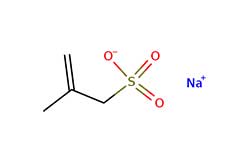Sodium methallyl sulfonate (CAS number: 1561-92-8) is a white crystalline powder. Its appearance is a white to nearly white powdery crystal with excellent physical stability. Due to its crystalline structure, it has high purity and stability in industrial applications.
The melting point of sodium methallyl sulfonate is greater than 300°C (lit.), indicating that the compound has high thermal stability at elevated temperatures. This property ensures the compound's chemical stability at high temperatures, making it suitable for industrial processes that require high-temperature operations.
At 20°C, the density of sodium methallyl sulfonate is 1.59 g/cm³. This density value indicates that it has a relatively high density at room temperature, making it suitable for applications requiring high-density materials.
At 20°C, the vapor pressure of sodium methallyl sulfonate is 0 Pa. This means that the compound is virtually non-volatile at room temperature, providing good stability and safety, making it suitable for use in open environments.
The sodium methallyl sulfonate should be stored under an inert atmosphere at room temperature. This storage condition helps prevent it from reacting with moisture or oxygen in the air, thereby maintaining its chemical stability.
At 20°C, the water solubility of sodium methallyl sulfonate is 523 g/L. This indicates that it has a very high solubility in water, making it suitable for applications requiring high solubility in aqueous solutions, such as dyes and flocculants.
At 20°C, the LogP value of sodium methallyl sulfonate is -3.74. This negative value indicates that it is highly hydrophilic, making it suitable for applications requiring high hydrophilicity, such as water treatment and dyes.
Sodium methallyl sulfonate is mainly used as the third monomer in the production of acrylic fiber. Acrylic fiber is a synthetic fiber widely used in the textile industry. By adding sodium methallyl sulfonate, the dyeing properties and thermal stability of the acrylic fiber can be significantly improved, allowing it to maintain good physical and chemical properties even in high-temperature environments. This characteristic grants it important application value in the production of high-performance textiles.
Sodium methallyl sulfonate is also used as a dyeing modifier for polyacrylonitrile fibers. By adding this compound, the dyeing uniformity and color fastness of the fibers can be enhanced. Additionally, it can be used as various reactive emulsifiers, flocculants, and water reducers for commercial concrete. In these applications, the high water solubility and good chemical stability of sodium methallyl sulfonate make it an ideal additive.
The production of sodium methallyl sulfonate requires anhydrous sodium sulfite and 3-chloro-2-methylpropene as raw materials. Anhydrous sodium sulfite is a bromide chemical raw material commonly used in various chemical reactions. 3-chloro-2-methylpropene is an important intermediate in organic synthesis; reacting it with anhydrous sodium sulfite produces sodium methallyl sulfonate.

Sodium methallyl sulfonate is a compound with excellent physical and chemical properties, widely used in the textile, chemical, and construction industries. Its high water solubility, good thermal stability, and chemical stability make it an important industrial raw material. Through proper storage and use, its advantages can be fully utilized in various application fields.